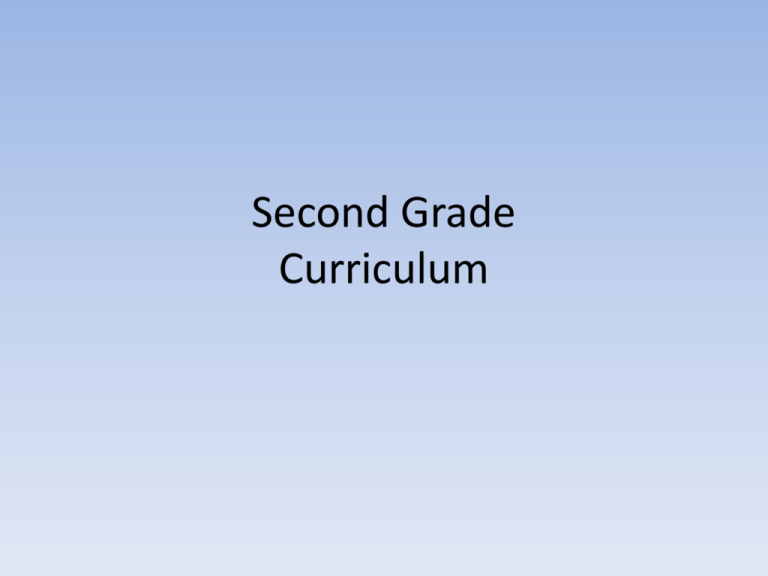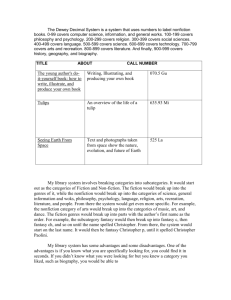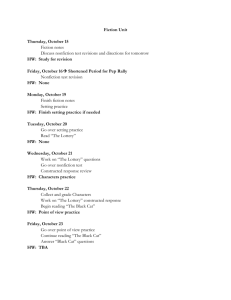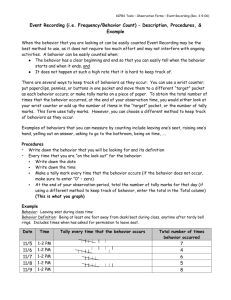Word Study
advertisement

Second Grade Curriculum Math Students will be able to… •Know addition facts (+1 through +10). •Make tally marks and give a total of tally marks. •Count by 2’s, 5’s, and 10’s up to 100. •Tells time to the nearest 5 minutes. •Make addition problems with an answer of 10. •Create two addition problems and two subtraction problems using three given numbers. •Show a given number using different ways (for example: tally marks, roman numerals, addition and subtraction problems, coins, etc.). •Find missing numbers in addition problems. •Know ones, tens, and hundreds place. •Know if a shape has symmetry. •Add or subtract 10 from any number. •Solve addition problems up to the nearest 10 (for example: 53 + __ = 60). •Use a ruler and tape measure to measure to the nearest half inch and half centimeter. •Color a given fraction of a shape. •Tell what fraction of a shape is colored. •Know value of a 2-, 3-, and 4- digit number. •Solve simple word problems. •Read and use dollar sign, cents sign, and decimal point correctly. •Add up coins and bills. Science Plants: Students will be able to… •Observe record and understand plant life cycle. •Identify what plants need in order to grow and live. •List ways that seeds travel. •Label parts of a seed and flowering plant. •Know purpose of each part of seed and plant. •Know a plant makes its own food. •Understand vocabulary words associated with plants (roots, stem, leaves, flower, pistil, seed, pollen). •Tell how plants adapt to their environment. Weather: Students will be able to… •Explain what weather is. •Identify temperature on the thermometer. •Name kinds of precipitation (rain, hail, snow, etc.). •Categorize characteristics of the four seasons. Balance and Motion: Students will be able to… •Identify objects that are in a stable/unstable position. •Label balance point. •Describe different ways objects move (roll, spin, glide, and float). •Identify a force (push/pull) that sets an object in motion. Health: Students will be able to… •Demonstrate the understanding of bus safety and good conduct. •Discuss, demonstrate, and practice the procedures to be followed in a fire drill or home safety situation. •Conduct themselves in a safe manner around animals. •Understand and demonstrate proper hand washing techniques. •Understand and explain proper dental hygiene. •Identify the six food groups from the current pyramid and classify foods into those groups. •Demonstrate the traits of good character (respect, responsibility, fairness, caring, trustworthiness and citizenship). Animals: Students will be able to… •Identify five groups of animals (mammals, fish, birds, amphibians, reptiles) and characteristics of each. •Match animals to their habitats. •Identify factors that affect animal growth, reproduction, and habitat. Social Studies Students will be able to… •Tell what a community is. •Explain urban, rural, and suburban communities. •Give examples of rules and laws. •Know needs and wants and give examples of places that meet our needs and wants. •Know leaders in the community. •Know difference between producer and consumer. •Know difference between a job that produces a good and a job that produces a service. •Tell ways to save and earn money. •List examples of good citizenship. •Know what symbols and keys are on a map. •Use a compass rose on a map. •Know where land, water, and continents are on a map. •Name the current president. •Name different jobs in the community. Reading Comprehension Strategies •State their thinking while reading. •Make meaningful connections to self, other books, and the world. •Self monitor to help understanding of text. •Ask questions before, during and after reading. •Make mental images in their heads while reading or listening to text. •Making and changing predictions as they read. Target Skills •Identify character, setting, problem, and solutions within a story. •Retell a story using beginning, middle, and end. •Choose books at their reading level. •Read and use second grade level words (again, always, because, come, does, every, from, goes, how, many, said, their, there, they, went, were, what, where, who, why, would, your, when). •Read text smoothly and accurately at a second grade level. •Retell plot. •Know the difference between fact and opinion. •Identify the author’s purpose (entertain, persuade, inform). •Compare and contrast different texts and characters. •Identify main idea. •Use context clues to understand word meanings within the text. •Identify cause and effect in a story. Decoding Strategies •Look for key words or picture clues. •Say the beginning sound and read the rest of the sentence. •Look for little words in big words. •Skip it and go on. •Ask if it makes sense. •Backtrack. Read it again. •Look and listen for letter patterns (multi-syllabic) •Does it sound right? Phonemic Awareness Students will be able to demonstrate… •Rhyming. •Blending sounds together to create a word. •Identify letter sounds at the beginning, middle and lend of words. Word Study •Students will demonstrate knowledge of phonics skills according to the whole Class Phonics scope and Sequence (attached). •Students will acquire phonics skills in progression through the developmental word study patterns and features according to the Small Group Phonics Scope and Sequence. Genre Students will be able to identify, describe and compare the following genres: •Fiction (fables, realistic fiction, fantasy) •Nonfiction •Poetry Reference Skills Students will be able to locate, identify and use… •Table of contents •Glossary •Guide words in a dictionary •Index •Captions •Words in alphabetical order to the second letter Vocabulary Students will be able to identify and apply the following concepts: •Onomatopoeia (sound words). •Synonyms (words that man the same thing). •Antonyms (words that are opposites). •Homonyms (words that are spelled the same and have different meaning). •Homophones (words that are spelled differently and have different meanings). Students will be able to: •Use context clues to determine the meaning of unknown words. •Relate unfamiliar words and concepts to prior knowledge to increase vocabulary. Writing The student will: •Write multiple sentences focusing on one topic in an order that makes sense (paragraph). Sentence will include a who (subject) and a what (predicate). The sentences will smoothly relate to the sentences around them (sentence fluency). •Generate a list of ides for writing. •Know that a noun is a person, place, or thing. •Know that a verb is an action a word. •Know that a pronoun is a word that replaces a noun (I, it, he, she, they, and we). •Use plural nouns appropriately. •Use periods, question marks, and exclamation points. •Capitalize first word of a sentence, names of people, and pronoun “I’. •Use compound words and contractions (snowman). Specials PE Students will… •Demonstrate rolling a ball with one hand from the side and stepping in opposition. •Demonstrate a throw using one hand, using follow through and stepping in opposition with non-throwing arm aiming towards targeted area. •Properly demonstrate a skip and slide. •Demonstrate the difference between shared and personal space. •Recognize and demonstrate bSAFE bFit exercises such as broccoli bump, stretching strawberry and lemon laps. Music The students will be able to: •Aurally identify simple rhythm patterns. •Identify repeated musical patterns. •Read and/ or play simple rhythm patterns using quarter note, half note, eighth notes, and quarter rest. •Demonstrate steady beat proficiently. •Demonstrate moods of music. Computer Students will… •Have knowledge of and use the keyboard keys, including the specialized keys. •Use appropriate technology terminology. •Understand and use developmentally appropriate multimedia programs that correlate to their classroom curriculum. Art •In the “weaving” unit, students will be able to execute an “A,B tabby weave”. •In the “Elements and Principles of Art” unit, students will identify and apply the principles of line (thick and thin) and shape (geometric and organic). •In the “Color Theory” unit, students will identify and apply the warm and cool color families to a completed piece of art. Library •Defines difference between fiction and nonfiction. •Recognizes call number and begins to understand grouping of materials by call number. •Asks a question about finding a book. •Identifies author, title page, illustrator, cover, and spine of print resources. •Recognized the need for citing sources and begins to make simple bibliographies. •Reads or listens to: traditional world literature/folklore, types of fiction in picture books, nonfiction (informational text including biography, poetry), and a variety of authors and illustrators. Comprehensive Resource http://teacherweb.com/IL/KanelandMcDole/MrBerger/sd3l7.aspx





